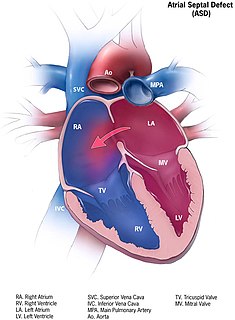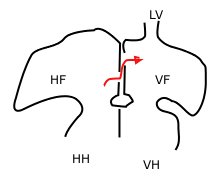
At the base of the skull, the foramen ovale is one of the larger of the several holes that transmit nerves through the skull. The foramen ovale is situated in the posterior part of the sphenoid bone, posterolateral to the foramen rotundum.

An air embolism, also known as a gas embolism, is a blood vessel blockage caused by one or more bubbles of air or other gas in the circulatory system. Air embolisms may also occur in the xylem of vascular plants, especially when suffering from water stress. Air can be introduced into the circulation during surgical procedures, lung over-expansion injury, decompression, and a few other causes.

Atrial septal defect (ASD) is a congenital heart defect in which blood flows between the atria of the heart. Some flow is a normal condition both pre-birth and immediately post-birth via the foramen ovale; however, when this does not naturally close after birth it is referred to as a patent (open) foramen ovale (PFO). It is common in patients with a congenital atrial septal aneurysm (ASA).

In the fetal heart, the foramen ovale, also foramen Botalli, or the ostium secundum of Born, allows blood to enter the left atrium from the right atrium. It is one of two fetal cardiac shunts, the other being the ductus arteriosus. Another similar adaptation in the fetus is the ductus venosus. In most individuals, the foramen ovale closes at birth. It later forms the fossa ovalis.

The interatrial septum is the wall of tissue that separates the right and left atria of the heart.

The septum secundum is a muscular flap that is important in heart development. It is semilunar in shape, and grows downward from the upper wall of the atrium immediately to the right of the septum primum and ostium secundum. It is important in the closure of the foramen ovale after birth.

Caenocara is a genus of beetles in the family Ptinidae. Members of this genus are sometimes called puffball beetles.
Caenocara affine is a species of anobiid beetle in the family Anobiidae. It is found in North America and Europe.
Caenocara blanchardi is a species of desert cockroach in the beetle family Ptinidae. It is found in North America.
Caenocara frontale is a species of anobiid beetle in the family Anobiidae. It is found in North America.
Caenocara ineptum is a species of anobiid beetle in the family Anobiidae. It is found in North America.
Caenocara laterale is a species of anobiid beetle in the family Anobiidae. It is found in North America.
Caenocara nigricorne is a species of anobiid beetle in the family Anobiidae. It is found in North America.
Caenocara scymnoides is a species of anobiid beetle in the family Anobiidae. It is found in North America.
Caenocara simile is a species of anobiid beetle in the family Anobiidae. It is found in North America.
Caenocara bicolor is a species of desert cockroach in the beetle family Ptinidae. It is found in North America.
Caenocara californicum is a species of anobiid beetle in the family Anobiidae. It is found in North America.
Caenocara neomexicanum is a species of anobiid beetle in the family Anobiidae. It is found in North America.
Caenocara tenuipalpum is a species of desert cockroach in the beetle family Ptinidae. It is found in North America.

Caenocara bovistae is a species of anobiid beetle in the family Anobiidae. It is found in Europe.







